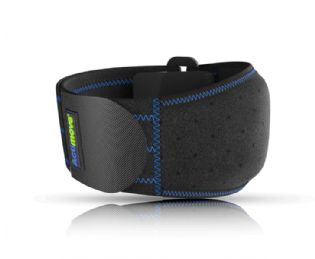

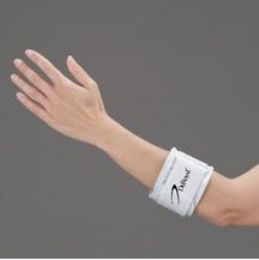
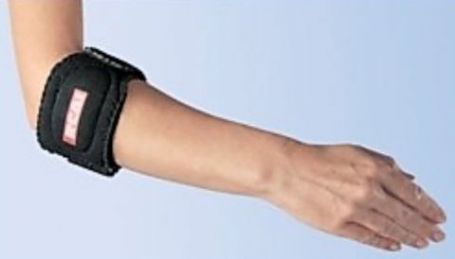
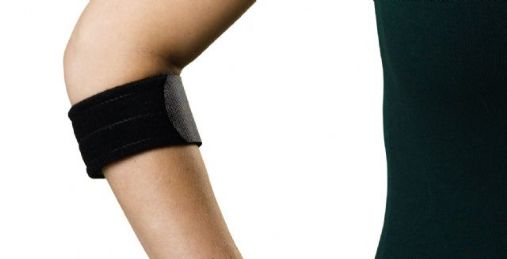
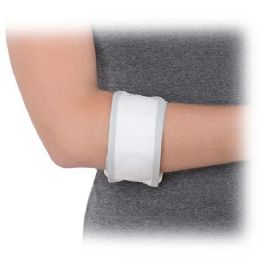
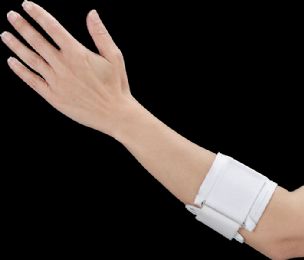
What is an Elbow or Forearm Strap?
An elbow or forearm strap is a type of orthotic device used to help reduce the symptoms connected with tennis elbow, tendinitis, and other similar conditions. Wearing this type of device typically minimizes the strain on tendons, ligaments and muscles between the elbow and wrist. It can also help prevent damage and pain due to overuse and swelling. The most common type of strap is a padded band with a Velcro cinch.
Generally, a conservative step in the treatment of forearm pain is the use of a forearm or elbow strap. The pain is commonly diagnosed as being symptomatic of lateral epicondylitis, a tendon related condition like tennis elbow. This injury is characterized by pain and stiffness in the elbow and down to the wrist, both while at rest and when aggravated during certain movements. Tennis elbow is not limited to those who play the game. It can happen as a repetitive stress injury in a wide variety of people who do a lot of work with their arms. Tennis elbow is the name normally given to the pain on the outside of the elbow, and golfer’s elbow refers to the pain on the inside of the elbow.
The normal use of a forearm or elbow strap calls for wearing it during waking hours for a period of several weeks. This is in addition to a conscious effort to rest the affected arm as much as possible, regular icing, and regular doses of anti-inflammatory and pain relieving medication. Cortisone injections and ultrasound are more aggressive treatments which may be needed, if advised by a medical professional. In severe cases, surgery may be necessary to repair the damage.
A forearm or elbow strap helps limit pain by compressing and isolating injured tendons in the elbow, as well as restricting their movement. This allows the damaged tissue the time it requires to repair itself without the risk of constant reinjury. The strap should be worn a short distance below the actual source of pain in the arm, not directly over it. To help strengthen the elbow area after it has sufficiently healed, physical therapy may be recommended. Although basic forearm straps are padded Velcro bands, there are additional features which some designs may offer. These include pneumatic bladders that can be inflated to increase compression, or gel inserts which can be frozen or heated to aid in the healing process. In order for a forearm or elbow strap to be effective, it is important that it is worn correctly.
What are Different Types of Tennis Elbow Supports?
Tennis elbow supports can be used to help improve range of motion and decrease pain around the elbow joint. Common supports include elbow straps, stabilizers, braces, compression sleeves, and bands. Compression sleeves slide over the forearm and onto the elbow to provide pressurized support for local connective tissues and muscles. A brace is a hinged support which prevents the arm from moving in certain directions. For example, a hyperextension support brace hinders rotation of the joint or stops the joint from moving past normal extension.
Tennis elbow straps may be used with or without an elbow sleeve and are often made from cotton and Lycra, or some other elastic material. Others are made from small bands of material with Velcro connections. They are used as pressure supports for the connective tissues and muscles of the elbow. Some straps are filled with air for added pressure, while others may use magnets to protect during activity. When using an elbow strap, it is important not to cut off circulation to the lower arm by pulling it too tight.
Since the muscles affected by tennis elbow run from the joint to the wrist, some support models connect two arm straps together for additional support. With this type, one band is tightened just below the elbow on the forearm and the other just above the wrist.
How do I Choose the Best Tennis Elbow Brace?
Tennis elbow tends to cause pain in the outer portion of the elbow. By utilizing the appropriate brace, it can help prevent or alleviate the pain associated with this condition. Depending on the level of pain that is being experienced and how active an individual is, one brace may be more appealing than another based on certain qualities, such as durability and comfort. There are many different types of braces available with different material compositions. What type of material a brace is made of contributes to its level of comfort, support, and durability. Two common types are nylon and neoprene. Nylon is normally a more breathable material, which could be important for those who sweat more than average. Neoprene, on the other hand, is softer and more flexible. Other possible material types are spandex and cotton.
In addition to what a brace is made of, there are different options that they offer. Some braces can be tightened or adjusted with straps, and others simply slip on. A hinged brace, which is a larger type, provides a high level of support with minimal range of motion and flexibility. Braces also come in various sizes and shapes, to fit individual needs and goals.
How do I Choose the Best Golfer’s Elbow Brace?
When choosing the best golfer’s elbow brace, determine why it is needed. A brace that protects the elbow from further aggravation will be best if the injury is at the beginning stages. Typically, this type offers support and warmth to the area without minimizing circulation. A brace that provides complete stabilization of the joint is better if the injury is causing a serious handicap to the elbow. This type prevents movements of the joint as well as ensuring enhanced results during the healing process.
Once the type of brace is determined, look for one that is of the proper weight. No matter how restrictive the brace is, it should be as light as possible. If the brace is too heavy, it can cause a shoulder injury or more serious issues later on. Ideally, it can be made of a lightweight material with Velcro fasteners. Metal fasteners can be used, but may place an unnecessary stress on the muscles of the arm. Each individual is different, therefore, choose a brace that meets specific needs and goals for each injury.
Rehabmart is pleased to offer a comprehensive selection of superior quality elbow and forearm straps and supports from credentialed and experienced medical vendors that include Restorative Care of America, North Coast, Medline, BSN Medical, Advanced Orthopaedics, DeRoyal, Bird & Cronin Inc., and United Surgical.
Hulet Smith, OT
Rehabmart Co-Founder & CEO
lb